 Toyota Yaris: Proper and efficient work procedures
Toyota Yaris: Proper and efficient work procedures
1. REMOVAL
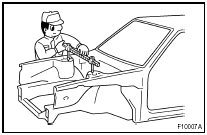
(a) PRE-REMOVAL MEASURING.
(1) Before removal or cutting operations, take measurements in accordance with the dimensions diagram. Always use a puller to straighten a damaged body or frame.

(b) CUTTING AREA.
(1) Always cut in a straight line and avoid reinforced areas.

(c) PRECAUTIONS FOR DRILLING OR CUTTING.
(1) Check behind any area to be drilled or cut to ensure that there are no hoses, wires, etc., that may be damaged.
HINT: See “Handling Precautions on Related Components” on page IN-15.

(d) REMOVAL OF ADJACENT COMPONENTS.
(1) When removing adjacent components, apply protective tape to the surrounding body and your tools to prevent damage.
HINT: See “Handling Precautions on Related Components” on page IN-15.

2. PREPARATION FOR INSTALLATION
(a) SPOT WELD POINTS.
(1) When welding panels with a combined thickness of over 3 mm (0.12 in.), use a MIG (Metal Inert Gas) welder for plug welding.
HINT: Spot welding does not provide sufficient durability for panels with a combined thickness of over 3 mm (0.12 in.).
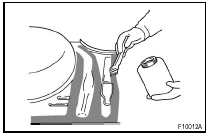
(b) APPLICATION OF WELD-THROUGH PRIMER (SPOT SEALER).
(1) Remove the paint from the portion of the new parts and body to be welded, and apply weld-through primer.

(c) MAKING HOLES FOR PLUG WELDING (1) For areas where a spot welder cannot be used, use a puncher or drill to make holes for plug welding.
REFERENCE: mm (in.)


(d) SAFETY PRECAUTIONS FOR ELECTRICAL COMPONENTS.
(1) When welding, there is a danger that electrical components will be damaged by the electrical current flowing through the body.
(2) Before starting work, disconnect the negative terminal of the battery and ground the welder near the welding location of the body.
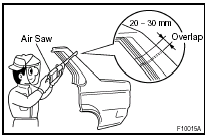
(e) ROUGH CUTTING OF JOINTS.
(1) For joint areas, rough cut the new parts, leaving 20 − 30 mm (0.79 − 1.18 in.) of overlap.
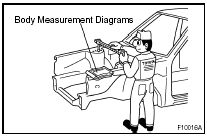
3. INSTALLATION
(a) PRE-WELDING MEASUREMENTS.
(1) Always take measurements before installing underbody or engine components to ensure correct assembly.
After installation, confirm proper fit.
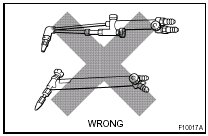
(b) WELDING PRECAUTIONS.
(1) The number of welding spots should be as follows.
Spot weld: 1.3 X No. of manufacturer’s spots.
Plug weld: More than No. of manufacturer’s plugs.
(2) Plug welding should be done with a MIG (Metal Inert Gas) welder. Do not gas weld or braze panels at areas other than specified.
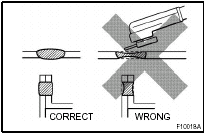
(c) POST-WELDING REFINISHING.
(1) Always check the welded spots to ensure they are secure.
(2) When smoothing out the weld spots with a disc grinder, be careful not to grind off too much as this will weaken the weld.

(d) SPOT WELD LOCATIONS.
(1) Avoid welding over previously welded areas.
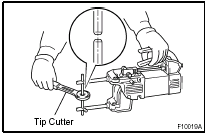
(e) SPOT WELDING PRECAUTIONS.
(1) The shape of the tip point of the spot welder significantly affects the strength of the weld. Therefore, maintain the tip point in the proper shape, and allow it to cool after every five or six spots.
(2) Completely remove the paint from the areas to be spot welded, including the seams and the surfaces that come in contact with the welding tip.
(3) Use a sander to remove any burrs that are created during spot welding.

4. ANTI-RUST TREATMENT AFTER INSTALLATION (BEFORE PAINTING PROCESS)
(a) BODY SEALER APPLICATION.
(1) For water-proofing and anti-corrosion measures, always apply the body sealer to the body panel seams and hems of the doors, hood, etc.
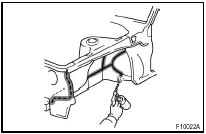
(b) UNDERCOAT APPLICATION.
(1) To prevent corrosion and protect the body from damage by flying stones, always apply sufficient undercoating to the bottom surface of the under body and inside of the wheel housings.
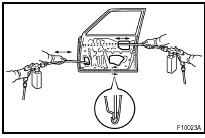
5. ANTI-RUST TREATMENT AFTER INSTALLATION (AFTER PAINTING PROCESS)
(a) ANTI-RUST AGENT (WAX) APPLICATION.
(1) To preserve impossible to paint areas from corrosion, always apply sufficient anti-rust agent (wax) to the inside of the hemming areas of the doors and hood, and around the hinges, or the welded surfaces inside the box-shaped cross sections of the side members, body pillar, etc.
6. ANTI-RUST TREATMENT BY PAINTING
REFERENCE: Painting prevents corrosion and protects the sheet metal from damage. In this section, anti-chipping paint only for anti-corrosion purpose is described.
(a) ANTI-CHIPPING PAINT.
(1) To prevent corrosion and protect the body from damage by flying stones, etc., apply anti-chipping paint to the rocker panel, wheel arch areas, balance panel, etc.
HINT: Depending on the model or the application area, there are cases where the application of anti-chipping paint is necessary before the second coat or after the top coat.

 How to use this manual
How to use this manual
1. BODY PANEL REPLACEMENT IN THIS MANUAL
2. SYMBOLS
The following symbols are used in the welding diagrams in section BP of this
manual to indicate cutting areas and the types of weld required ...
 Handling precautions on related components
Handling precautions on related components
1. BRAKE SYSTEM
The brake system is one of the most important safety components. Always follow
the directions and notes given in the brake (32) section of the repair manual for
the relevant model ...
See also:
Adhesive Application Area Work Procedure
NOTE.
This vehicle has areas on the Quarter Panel and Quarter Wheel Housing Outer Panel
that are joined together only with adhesive. It is necessary to conduct the correct
repair procedures for h ...
General information
1. BASIC DIMENSIONS
(a) There are two types of dimensions in the diagram.
(1) (Three-dimensional distance).
Straight-line distance between the centers of two measuring points.
(2) (Two-dimensi ...
Back door opening trough (ASSY)
REPLACEMENT
With the quarter panel and body lower back panel removed.
REMOVAL
INSTALLATION
Temporarily install the new parts and measure each part of the new parts in accordance
with the bod ...
